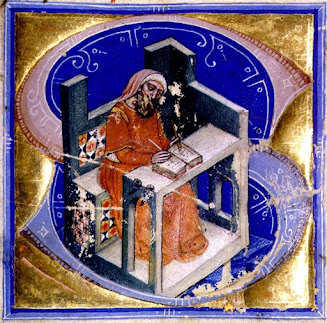 |
| Chronicler from the Illuminated Chronicle, c. 1360 |
I started this blog 10 years ago, in August 2010. Originally, the idea was to try another platform, in order to provide up-to-date information – information that was hard to provide on my rudimentary website Art in Medieval Hungary. I created the first incarnation of the website in 1998, and by around 2005, it existed in its current form, with frequent updates until about 2011. Incredibly, the website is still up and running (although I no longer have access to update it). Both the website and the blog grew out of the frustration that there is almost no information available about the art of Medieval Hungary in the current English-language scholarship. One of the largest and most stable kingdoms of medieval Europe is usually just a vast empty expanse, a terra incognita in survey works and overviews of medieval art. I can identify at least three reasons for this: first, the medieval Kingdom of Hungary collapsed after the 1526 battle of Mohács and the 150 years of Ottoman rule that followed in much of the country had disastrous consequences. The central areas of medieval Hungary and its culture along with it were obliterated in this period, and even greater destruction took place at the time of the sieges of re-conquest in the seventeenth century and during the rebuilding and modernization after. Coupled with the well-known effects of the Reformation on medieval ecclesiastical art, there are vast areas of Hungary where there is almost nothing left from the medieval period (at least as far as visual arts are concerned).
Neither destruction nor modernization affected each part of Hungary equally. The outer areas (with the exception of the southern border), in particular preserved a large part of their medieval heritage, including countless churches still in use. And here we come to the second reason: following the Treaty of Trianon after WWI, these regions are no longer part of Hungary, as they were ceded to newly-formed states. Today the great majority of important medieval sites from the medieval Kingdom of Hungary are found in the neighboring Central European states – especially in Slovakia and Romania (Transylvania). And here we reach the third obstacle: language. Most literature on the art of medieval Hungary is written in Hungarian – but there is also significant literature in Slovak and Romanian, not to mention the languages of all the other countries bordering Hungary. Also, most places have at least three names in the literature – a Hungarian name, a name in the language of modern nation-states, and a German name – creating a lot of confusion at times.
When it comes to the first two historical factors, there is not much we can do about them – we just have to be aware of these factors when writing about medieval Hungary, and deal with them as best as we can. However, there is an easy way to fix the third factor: more publications are needed in English and German about medieval Hungary. As such publications were few and far between, I felt the need for this blog, to provide timely information about the research of medieval Hungary, and to call attention to new publications in more accessible languages.
 |
| Detail from the Legend of Saint Ladislas, at Homoródkarácsonyfalva (Crăciunel, RO) |



:strip_icc()/BHG_PTSN19720-33d9cd22f6ab49e6a21982e451321898.jpg)

More Stories
Gurney Journey: USA Today Recommends Dinotopia
“From Generation to Generation…” — A Sanctified Art
The Public Theater’s Under The Radar Festival Lights Up NYC This January